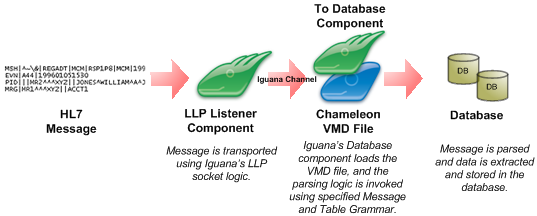

Setting Up the Channels |
By this stage you are set to go, now that the parsing logic is figured out. The next step is setting up your channels in Iguana. Unlike Chameleon, you don't have to think about good logging strategies, or what things your code should check for, since Iguana handles the message transport and delivery, logging, administration (start/stop) and monitoring functions right out of the box.
The only thing you need to worry about is what type of channel configuration you want to set up. The type of channel you set up depends on what type of function your HL7 interface is performing: (1) Parsing; (2) Generating; (3) Transforming; and/or (4) Translating.
Some common channel setups are described in the following diagrams:
Parsing
- Parse a wide variety of HL7 formats into a database using Iguana's LLP Listener and To Database components:

Iguana Parsing Example
To go through a step-by-step parsing example, see HL7 to Database.
Generating
- Generate customizable HL7 from a database using Iguana's From Database and LLP Client components:

Iguana Generation Example
To go through a step-by-step generating example, see Database to HL7.
Transforming
- Transform incoming HL7 messages into altered outgoing HL7 messages from Iguana using the Filter capability and the Channel components:

Iguana Transformation Example
To go through a step-by-step transformation example, see HL7 Transformation.
| This diagram shows the transformation process that is used in versions of Iguana starting with version 4.0. Earlier versions of Iguana use message filter components to transform messages. The transformation example describes how to transform messages using versions of Iguana starting with version 4.0 and earlier versions of Iguana. | ||
 |
Translating
- Translate HL7 messages to/from XML using one of the five supported XML translation schemes from Iguana defined in Iguana's Filter capability:

Iguana Translation Example
To go through a step-by-step XML translation example, see HL7 - XML Tutorial.
| This diagram shows the translation process that is used in versions of Iguana starting with version 4.0. Earlier versions of Iguana use XML components to translate messages to and from XML. The translation example describes how to translate messages using versions of Iguana starting with version 4.0 and earlier versions of Iguana. | ||
 |